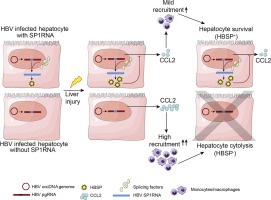当前位置:
X-MOL 学术
›
J. Hepatol.
›
论文详情
Our official English website, www.x-mol.net, welcomes your
feedback! (Note: you will need to create a separate account there.)
Alternative splicing of hepatitis B virus: A novel virus/host interaction altering liver immunity
Journal of Hepatology ( IF 26.8 ) Pub Date : 2017-10-01 , DOI: 10.1016/j.jhep.2017.05.025 Marion Duriez 1 , Yassmina Mandouri 2 , Bouchra Lekbaby 1 , Hualin Wang 1 , Aurélie Schnuriger 3 , Francois Redelsperger 1 , Chiara Ida Guerrera 4 , Marine Lefevre 5 , Veronique Fauveau 6 , James Ahodantin 1 , Ivan Quetier 1 , Cerina Chhuon 4 , Samir Gourari 7 , Alexandre Boissonnas 1 , Upkar Gill 8 , Patrick Kennedy 8 , Nabil Debzi 9 , Delphine Sitterlin 10 , Mala K Maini 11 , Dina Kremsdorf 1 , Patrick Soussan 12
Journal of Hepatology ( IF 26.8 ) Pub Date : 2017-10-01 , DOI: 10.1016/j.jhep.2017.05.025 Marion Duriez 1 , Yassmina Mandouri 2 , Bouchra Lekbaby 1 , Hualin Wang 1 , Aurélie Schnuriger 3 , Francois Redelsperger 1 , Chiara Ida Guerrera 4 , Marine Lefevre 5 , Veronique Fauveau 6 , James Ahodantin 1 , Ivan Quetier 1 , Cerina Chhuon 4 , Samir Gourari 7 , Alexandre Boissonnas 1 , Upkar Gill 8 , Patrick Kennedy 8 , Nabil Debzi 9 , Delphine Sitterlin 10 , Mala K Maini 11 , Dina Kremsdorf 1 , Patrick Soussan 12
Affiliation

|
BACKGROUND & AIMS
Hepatitis B virus (HBV) RNA can undergo alternative splicing, but the relevance of this post-transcriptional regulation remains elusive. The mechanism of HBV alternative splicing regulation and its impact on liver pathogenesis were investigated. METHODS
HBV RNA-interacting proteins were identified by RNA pull-down, combined with mass spectrometry analysis. HBV splicing regulation was investigated in chemically and surgically induced liver damage, in whole HBV genome transgenic mice and in hepatoma cells. Viral and endogenous gene expression were quantified by quantitative reverse transcription polymerase chain reaction, Western blot and enzyme-linked immunosorbent assay. Resident liver immune cells were studied by fluorescence-activated cell sorting. RESULTS
HBV pregenomic RNA-interacting proteins were identified and 15% were directly related to the splicing machinery. Expression of these splicing factors was modulated in HBV transgenic mice with liver injuries and contributed to an increase of the HBV spliced RNA encoding for HBV splicing-generated protein (HBSP). HBSP transgenic mice with chemically induced liver fibrosis exhibited attenuated hepatic damage. The protective effect of HBSP resulted from a decrease of inflammatory monocyte/macrophage recruitment through downregulation of C-C motif chemokine ligand 2 (CCL2) expression in hepatocytes. In human hepatoma cells, the ability of HBSP to control CCL2 expression was confirmed and maintained in a whole HBV context. Finally, viral spliced RNA detection related to a decrease of CCL2 expression in the livers of HBV chronic carriers underscored this mechanism. CONCLUSION
The microenvironment, modified by liver injury, increased HBSP RNA expression through splicing factor regulation, which in turn controlled hepatocyte chemokine synthesis. This feedback mechanism provides a novel insight into liver immunopathogenesis during HBV infection. Lay summary: Hepatitis B virus persists for decades in the liver of chronically infected patients. Immune escape is one of the main mechanisms developed by this virus to survive. Our study highlights how the crosstalk between virus and liver infected cells may contribute to this immune escape.
中文翻译:

乙型肝炎病毒的可变剪接:一种改变肝脏免疫的新型病毒/宿主相互作用
背景和目的 乙型肝炎病毒 (HBV) RNA 可以进行可变剪接,但这种转录后调控的相关性仍然难以捉摸。研究了HBV可变剪接调控的机制及其对肝脏发病机制的影响。方法通过RNA pull-down结合质谱分析鉴定HBV RNA相互作用蛋白。在化学和手术诱导的肝损伤、整个 HBV 基因组转基因小鼠和肝癌细胞中研究了 HBV 剪接调节。通过定量逆转录聚合酶链反应、蛋白质印迹和酶联免疫吸附测定对病毒和内源基因表达进行量化。通过荧光激活细胞分选研究常驻肝脏免疫细胞。结果鉴定出HBV前基因组RNA相互作用蛋白,15%与剪接机制直接相关。这些剪接因子的表达在肝损伤的 HBV 转基因小鼠中受到调节,并导致编码 HBV 剪接生成蛋白 (HBSP) 的 HBV 剪接 RNA 增加。具有化学诱导肝纤维化的 HBSP 转基因小鼠表现出减轻的肝损伤。HBSP 的保护作用是由于通过下调肝细胞中 CC 基序趋化因子配体 2 (CCL2) 的表达来减少炎症性单核细胞/巨噬细胞募集。在人肝癌细胞中,HBSP 控制 CCL2 表达的能力得到证实并在整个 HBV 环境中保持。最后,与HBV慢性携带者肝脏中CCL2表达降低相关的病毒剪接RNA检测强调了这种机制。结论肝损伤后的微环境通过剪接因子调控增加了HBSP RNA的表达,进而控制了肝细胞趋化因子的合成。这种反馈机制为了解 HBV 感染期间的肝脏免疫发病机制提供了新的见解。总结:乙型肝炎病毒在慢性感染患者的肝脏中持续存在数十年。免疫逃逸是这种病毒发展出来的主要生存机制之一。我们的研究强调了病毒和肝脏感染细胞之间的串扰如何促成这种免疫逃逸。进而控制肝细胞趋化因子的合成。这种反馈机制为了解 HBV 感染期间的肝脏免疫发病机制提供了新的见解。总结:乙型肝炎病毒在慢性感染患者的肝脏中持续存在数十年。免疫逃逸是这种病毒发展出来的主要生存机制之一。我们的研究强调了病毒和肝脏感染细胞之间的串扰如何促成这种免疫逃逸。进而控制肝细胞趋化因子的合成。这种反馈机制为了解 HBV 感染期间的肝脏免疫发病机制提供了新的见解。总结:乙型肝炎病毒在慢性感染患者的肝脏中持续存在数十年。免疫逃逸是这种病毒发展出来的主要生存机制之一。我们的研究强调了病毒和肝脏感染细胞之间的串扰如何促成这种免疫逃逸。
更新日期:2017-10-01
中文翻译:

乙型肝炎病毒的可变剪接:一种改变肝脏免疫的新型病毒/宿主相互作用
背景和目的 乙型肝炎病毒 (HBV) RNA 可以进行可变剪接,但这种转录后调控的相关性仍然难以捉摸。研究了HBV可变剪接调控的机制及其对肝脏发病机制的影响。方法通过RNA pull-down结合质谱分析鉴定HBV RNA相互作用蛋白。在化学和手术诱导的肝损伤、整个 HBV 基因组转基因小鼠和肝癌细胞中研究了 HBV 剪接调节。通过定量逆转录聚合酶链反应、蛋白质印迹和酶联免疫吸附测定对病毒和内源基因表达进行量化。通过荧光激活细胞分选研究常驻肝脏免疫细胞。结果鉴定出HBV前基因组RNA相互作用蛋白,15%与剪接机制直接相关。这些剪接因子的表达在肝损伤的 HBV 转基因小鼠中受到调节,并导致编码 HBV 剪接生成蛋白 (HBSP) 的 HBV 剪接 RNA 增加。具有化学诱导肝纤维化的 HBSP 转基因小鼠表现出减轻的肝损伤。HBSP 的保护作用是由于通过下调肝细胞中 CC 基序趋化因子配体 2 (CCL2) 的表达来减少炎症性单核细胞/巨噬细胞募集。在人肝癌细胞中,HBSP 控制 CCL2 表达的能力得到证实并在整个 HBV 环境中保持。最后,与HBV慢性携带者肝脏中CCL2表达降低相关的病毒剪接RNA检测强调了这种机制。结论肝损伤后的微环境通过剪接因子调控增加了HBSP RNA的表达,进而控制了肝细胞趋化因子的合成。这种反馈机制为了解 HBV 感染期间的肝脏免疫发病机制提供了新的见解。总结:乙型肝炎病毒在慢性感染患者的肝脏中持续存在数十年。免疫逃逸是这种病毒发展出来的主要生存机制之一。我们的研究强调了病毒和肝脏感染细胞之间的串扰如何促成这种免疫逃逸。进而控制肝细胞趋化因子的合成。这种反馈机制为了解 HBV 感染期间的肝脏免疫发病机制提供了新的见解。总结:乙型肝炎病毒在慢性感染患者的肝脏中持续存在数十年。免疫逃逸是这种病毒发展出来的主要生存机制之一。我们的研究强调了病毒和肝脏感染细胞之间的串扰如何促成这种免疫逃逸。进而控制肝细胞趋化因子的合成。这种反馈机制为了解 HBV 感染期间的肝脏免疫发病机制提供了新的见解。总结:乙型肝炎病毒在慢性感染患者的肝脏中持续存在数十年。免疫逃逸是这种病毒发展出来的主要生存机制之一。我们的研究强调了病毒和肝脏感染细胞之间的串扰如何促成这种免疫逃逸。











































 京公网安备 11010802027423号
京公网安备 11010802027423号